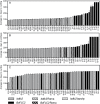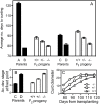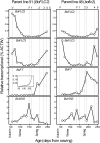The role of BoFLC2 in cauliflower (Brassica oleracea var. botrytis L.) reproductive development
- PMID: 25355864
- PMCID: PMC4265156
- DOI: 10.1093/jxb/eru408
The role of BoFLC2 in cauliflower (Brassica oleracea var. botrytis L.) reproductive development
Abstract
In agricultural species that are sexually propagated or whose marketable organ is a reproductive structure, management of the flowering process is critical. Inflorescence development in cauliflower is particularly complex, presenting unique challenges for those seeking to predict and manage flowering time. In this study, an integrated physiological and molecular approach was used to clarify the environmental control of cauliflower reproductive development at the molecular level. A functional allele of BoFLC2 was identified for the first time in an annual brassica, along with an allele disrupted by a frameshift mutation (boflc2). In a segregating F₂ population derived from a cross between late-flowering (BoFLC2) and early-flowering (boflc2) lines, this gene behaved in a dosage-dependent manner and accounted for up to 65% of flowering time variation. Transcription of BoFLC genes was reduced by vernalization, with the floral integrator BoFT responding inversely. Overall expression of BoFT was significantly higher in early-flowering boflc2 lines, supporting the idea that BoFLC2 plays a key role in maintaining the vegetative state. A homologue of Arabidopsis VIN3 was isolated for the first time in a brassica crop species and was up-regulated by two days of vernalization, in contrast to findings in Arabidopsis where prolonged exposure to cold was required to elicit up-regulation. The correlations observed between gene expression and flowering time in controlled-environment experiments were validated with gene expression analyses of cauliflowers grown outdoors under 'natural' vernalizing conditions, indicating potential for transcript levels of flowering genes to form the basis of predictive assays for curd initiation and flowering time.
Keywords: BoFLC; BoFT; BoVIN3; Brassica oleracea; cauliflower; expression; flowering time; vernalization..
© The Author 2014. Published by Oxford University Press on behalf of the Society for Experimental Biology.
Figures





Similar articles
-
A 215-bp indel at intron I of BoFLC2 affects flowering time in Brassica oleracea var. capitata during vernalization.Theor Appl Genet. 2022 Aug;135(8):2785-2797. doi: 10.1007/s00122-022-04149-1. Epub 2022 Jun 28. Theor Appl Genet. 2022. PMID: 35760921
-
Mapping and characterization of FLC homologs and QTL analysis of flowering time in Brassica oleracea.Theor Appl Genet. 2007 Feb;114(4):595-608. doi: 10.1007/s00122-006-0460-6. Epub 2006 Nov 29. Theor Appl Genet. 2007. PMID: 17136371
-
Meristem identity gene expression during curd proliferation and flower initiation in Brassica oleracea.J Exp Bot. 2008;59(2):421-33. doi: 10.1093/jxb/erm327. J Exp Bot. 2008. PMID: 18332227
-
Make hay when the sun shines: the role of MADS-box genes in temperature-dependant seasonal flowering responses.Plant Sci. 2011 Mar;180(3):447-53. doi: 10.1016/j.plantsci.2010.12.001. Epub 2010 Dec 14. Plant Sci. 2011. PMID: 21421391 Review.
-
Control of Arabidopsis flowering: the chill before the bloom.Development. 2004 Aug;131(16):3829-38. doi: 10.1242/dev.01294. Development. 2004. PMID: 15289433 Review.
Cited by
-
Epigenetic regulation of agronomical traits in Brassicaceae.Plant Cell Rep. 2018 Jan;37(1):87-101. doi: 10.1007/s00299-017-2223-z. Epub 2017 Oct 20. Plant Cell Rep. 2018. PMID: 29058037 Review.
-
Genome-Wide Identification and Analysis of the Plant Cysteine Oxidase (PCO) Gene Family in Brassica napus and Its Role in Abiotic Stress Response.Int J Mol Sci. 2023 Jul 8;24(14):11242. doi: 10.3390/ijms241411242. Int J Mol Sci. 2023. PMID: 37511002 Free PMC article.
-
A 215-bp indel at intron I of BoFLC2 affects flowering time in Brassica oleracea var. capitata during vernalization.Theor Appl Genet. 2022 Aug;135(8):2785-2797. doi: 10.1007/s00122-022-04149-1. Epub 2022 Jun 28. Theor Appl Genet. 2022. PMID: 35760921
-
Non-vernalization Flowering and Seed Set of Cabbage Induced by Grafting Onto Radish Rootstocks.Front Plant Sci. 2019 Jan 10;9:1967. doi: 10.3389/fpls.2018.01967. eCollection 2018. Front Plant Sci. 2019. PMID: 30687362 Free PMC article.
-
Genetic variation of temperature-regulated curd induction in cauliflower: elucidation of floral transition by genome-wide association mapping and gene expression analysis.Front Plant Sci. 2015 Sep 10;6:720. doi: 10.3389/fpls.2015.00720. eCollection 2015. Front Plant Sci. 2015. PMID: 26442034 Free PMC article.
References
-
- Andrés F, Coupland G. 2012. The genetic basis of flowering responses to seasonal cues. Nature Reviews Genetics 13, 627–639. - PubMed
-
- Bernier G, Perilleux C. 2005. A physiological overview of the genetics of flowering time control. Plant Biotechnology Journal 3, 3–16. - PubMed
-
- Cerdán PD, Chory J. 2003. Regulation of flowering time by light quality. Nature 423, 881–885. - PubMed
-
- Friend DJC. 1985. Brassica. In: Halevy AH, eds. CRC Handbook of flowering . Boca Raton: CRC Press, Inc., 48–77.
Publication types
MeSH terms
Substances
LinkOut - more resources
Full Text Sources
Other Literature Sources
Molecular Biology Databases
Miscellaneous

